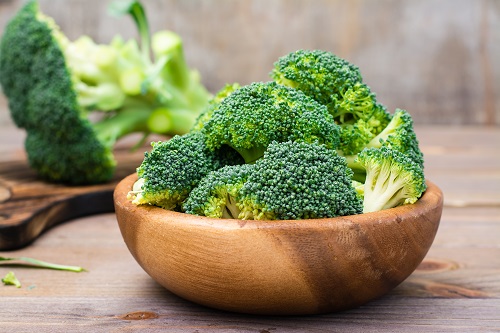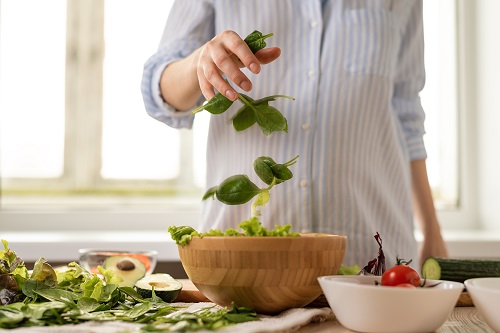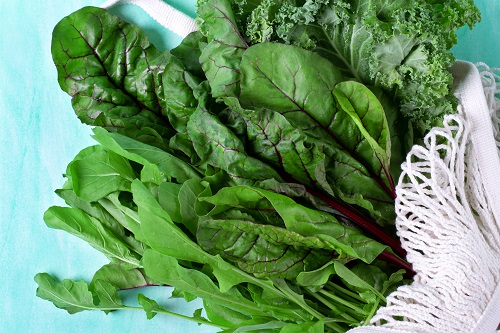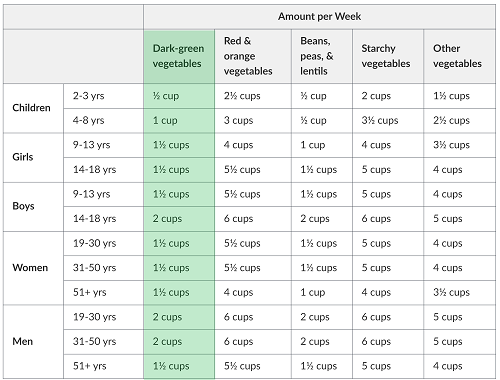This Food Talk Features blog is about all things green! Well… Green vegetables! Dark green vegetables support a healthy heart, digestive system, and everything in between. Learn why we love this veggie sub-group.
Each month this year, we are featuring a different food group or sub-group as part of our Food Talk Features… Series. Last month, we learned about red and orange vegetables! Their bright colors are from beta-carotene. Eating enough red and orange vegetables will help with eyesight, skin health, and immunity. Check out more from that blog here.
This month, we’re diving into another vegetable sub-group: Dark green vegetables! Other vegetable subgroups include:
- Red and orange vegetables
- Beans, peas, and lentils
- Starchy vegetables
- And other vegetables. [1]

What’s so special about dark green vegetables?
Dark green vegetables are grouped together because of their dark green color. These veggies are a great source of the following:
This sub-group is a nutrient powerhouse! Dark green vegetables are also naturally low in calories, sodium, and fat.
Eating dark green vegetables is an easy way to add fiber into your diet. Fiber is important for keeping us full between meals. This helps with weight management. Fiber also helps to control blood sugar. It does this by slowing down the movement of sugar into the bloodstream. In the process, fiber picks up cholesterol in the blood to improve cholesterol levels. Finally, it attaches to other food to slow digestion and support a healthy digestive system. [4]

Folate (folic acid) helps the body make red blood cells. Enough folate is very important for women who may become pregnant. [5] Iron is also needed for healthy blood cells—iron gives blood its red color!
Other nutrients like vitamin K and calcium are needed for healthy bones. Read more about bone health in our Healthy Bones and Aging blog.
Vitamin C and antioxidants support our immune system for a long and healthy life. Dark green vegetables are full of many antioxidants! Antioxidants may help to prevent chronic diseases like cancer and heart disease. [2] [3] [6]

Examples of dark green vegetables are:
- Broccoli
- Greens, such as collards, mustard greens, turnip greens, and kale
- Spinach
- Dark leafy greens like watercress
- Lettuce like romaine, dark green leafy lettuce, endive, and escarole
How much do I need?
1 cup of broccoli florets or cooked leafy greens counts as a 1-cup-serving of dark green vegetables. 2 cups of raw leafy greens count as a 1-cup-serving, too. This is because of how loose the leaves are when they are uncooked.
People should aim for 1-3 cups of total vegetables a day. However, sub-group suggestions are based on how much we should try to eat every week.
Check out the Weekly Vegetable Subgroup Table from MyPlate below to learn how many servings of dark green vegetables to aim for each week:
- Children (2-8 years old): ½-1 cup
- Girls (9-18 years old): 1 ½ cups
- Boys (9-18 years old): 1 ½-2 cups
- Women (19-50 years old): 1 ½ cups
- Women 51 years and above: 1 ½ cups
- Men (19-50 years old): 2 cups
- Men 50 years and above: 1 ½ cups

Enjoying Dark Green Vegetables
Dark green veggies grow well in Georgia and home gardens! UGA SNAP-Ed includes plenty of these veggies in our recipes because they are common and affordable. Check out these yummy ways to enjoy dark green veggies:
- In baked goods and spreads:
- Take a bite out of these Collard Green Cornbread Muffins!
- Try collards in a different way with our Greens and Beans Dip.
- Serve in a soup:
- Slow–Cooker West African Peanut Stew and Crockpot Vegetable Lentil Stew both use chopped kale.
- Pueblo Chili uses tender spinach leaves.
- Enjoy as a salad:
- Try the Harvest Kale Salad for a savory taste.
- For a sweet and savory kick, try the Kale and Orange Salad or Green Salad with Pineapple.
- Our Spinach and Romaine Salad with Strawberries and Poppyseed Dressing is also packed with dark green veggie nutrition!
- Make in a pan:
- As a main dish, try Italian Broccoli Noodles.
- For a side dish, give the Greens with Beans or Broccoli and Sweet Pepper Stir Fry a go!
- Add a pop of color:
- Enjoy these Buffalo Cauliflower Tacos some green with chopped spinach.
- Breakfast gets a makeover with Turmeric Scrambled Eggs and Oven Spinach Frittata!
- Pasta is made even better with greens! Try the Vegan Mac & Cheese with Collards or Skillet Mac and Cheese with broccoli. Tuscan Pasta and Slow Cooker Vegetarian Lasagna with spinach are also delicious!
Written by Melanie Ng, PhD Student | Edited by Leslie Davis, MS, RDN, LDN, CDCES and the Nutrition Education Team
Posted: March 15, 2021
[2] UK Ag Extension—Dark Green Leafy Vegetables

